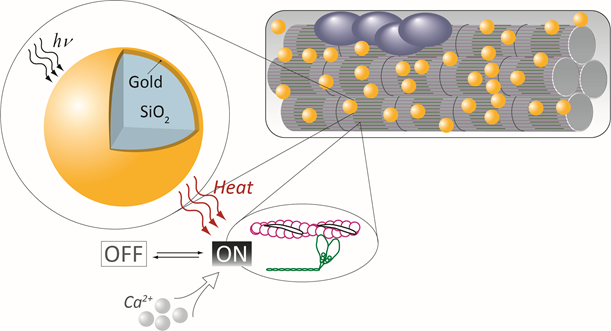Near-infrared radiation for remote activation of muscle cells
Tue, Mar 21, 2017-
Tags
New method using nanotechnology is safer and more precise
Researchers developed a new method for remotely controlling skeletal muscles, using near-infrared radiation to mildly heat gold nanoshells attached to muscle tissues. This new process avoids negative side effects of previous methods, and is already being used in several clinical and preclinical applications, including cancer therapy and neural cell stimulation. It may possibly be used for deep tissues as well.
The research appeared online on ACS Nano by the American Chemical Society. It was also introduced in the news and views section of Nature Publishing Group’s Nature Nanotechnology.

Various ways have been proposed to stimulate muscle cells and induce muscle contraction. Though electrical stimulation is proven to be effective, disadvantages include uneven response and release of toxic species caused by electrolysis. Therefore, alternative methods have been called for.
Researchers from Italy, Japan and Singapore develop new method
A research group co-led by Madoka Suzuki of Waseda University developed a new technique using gold nanoshells, nanoparticles about 120nm in diameter, made of a silica core coated with 10nm of gold. Applying near-infrared radiation of 800nm heats cells containing the gold nanoshells, through a phenomenon known as photothermal conversion, which activates specific proteins and induces muscle contraction. Whereas other common methods cause “spillover” stimulation of surrounding tissues, this technique enables activation of specific areas through targeted placement of the gold nanoshells. The new process also avoids calcium fluxes which damage muscle cells.
These findings show great potential in the fields of muscle tissue engineering, regenerative medicine and bionics. Gold nanoshells have also been added to hydrogels to create thermally responsive polymers for drug delivery to deep tissues. Other promising applications include heat-induced tissue welding for laceration treatment and absorbance-based biosensing for the quantification of biomarkers in whole blood.
For more information on this research, contact Madoka Suzuki ([email protected]), Researcher at Waseda Bioscience Research Institute in Singapore (WABIOS).
Future work will focus on the translation of this approach to muscle tissues in vivo, as well as investigation of the role of chronic photothermal stimulation on mitochondrial biogenesis and on myocyte differentiation.
Published article
- Journal: American Chemical Society(ACS)ACS Nano
- Title: Gold Nanoshell-Mediated Remote Myotube Activation
- Authors: Attilio Marino (Instituto Italiano di Tecnologia)*, Satoshi Arai (Waseda University), Yanyan Hou (Waseda University), Andrea Degl’Innocenti (Instituto Italiano di Tecnologia), Valentina Cappello (Instituto Italiano di Tecnologia), Barbara Mazzolai (Instituto Italiano di Tecnologia), Young-Tae Chang (National University of Singapore), Virgilio Mattoli (Instituto Italiano di Tecnologia), Madoka Suzuki (Waseda University, Japan Science and Technology Agency)*, Gianni Ciofani (Instituto Italiano di Tecnologia)*
- Corresponding authors are marked with an asterisk (*)
- Website: http://pubs.acs.org/doi/abs/10.1021/acsnano.6b08202
Reference
- Arai, S., Lee, S.-C., Zhai, D., Suzuki, M. and Chang, Y.-T. A molecular fluorescent probe for targeted visualization of temperature at the endoplasmic reticulum. Sci. Rep., 4, 6701 (2014)
- Itoh, H., Arai, S., Sudhaharan, T., Lee, S.-C., Chang, Y-T., Ishiwata, S.,* Suzuki, M.* and Lane, E. B.* Direct organelle thermometry with fluorescence lifetime imaging microscopy in single myotubes. Chem. Commun., 52, 4458-4461 (2016)
- Oyama, K., Mizuno, A., Shintani, S.A., Itoh, H., Serizawa, T., Fukuda, N., Suzuki, M.* and Ishiwata, S.* (*Corresponding authors) Microscopic heat pulses induce contraction of cardiomyocytes without calcium transients. Biochem. Biophys. Res. Commun., 417, 607-612 (2012)













